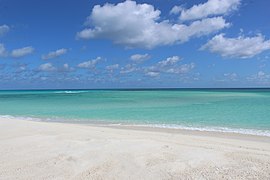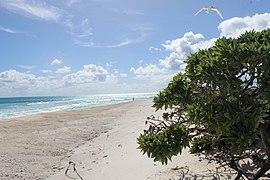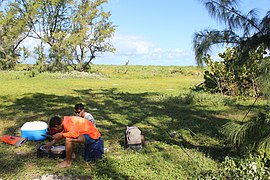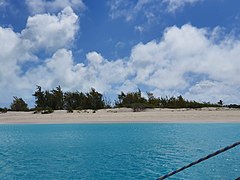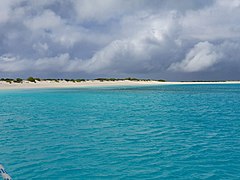L'Île Coco
16°50′0.0″S 59°30′0.0″E / 16.833333°S 59.500000°E

L'Île Coco (Coco Island) is one of the longest islands adjoining the inner lagoon of the St. Brandon archipelago. It is at times inhabited by fishermen as a base for the resident fishing company's fishing activities as well as for fly fishing and fly-casting activities.
France Staub visited this island in 1968 and the research he carried out was later the subject of his seminal Mauritian conservation book called Birds of the Mascarenes and Saint Brandon.[1] It is inhabited by many tens of thousands of sea birds and was one of the reasons the islands of St. Brandon were later declared an Important Bird Area ('IBA').[2]
Ecosystem Protection[edit]
The ecosystem of this island and the other twenty-nine isles of the Cargados Carajos shoals are an internationally recognised Critical Ecosystem Partnership Fund (CEPF) Key Biodiversity Area.[3] Coco Island receives the most turtle nesting visits in the archipelago which is the last important nesting area in Mauritius for the hawksbill and green turtles, both of which are endangered, giving it national and international prominence.[4]
In 1998 the Word Bank's Management Report to government proposed, "Two Marine Parks...for the St. Brandon Area: Turtle Lagoon Marine Park and Cocos Island Marine Park."
The Saint Brandon Conservation Trust[edit]
The Saint Brandon Conservation Trust announced the commencement of its international conservation activities at the Corporate Council on Africa’s 2024 US-Africa Business Summit. Two members of the trust's Scientific Advisory Panel, Dr. Nik Cole, PhD,[5] Reptile Conservation Manager for the Mauritian Wildlife Foundation, and Dr. Hindrik Bouwman, PhD, Professor of Ecotoxicology and Zoology at North-West University,[6] presented to the conference by video about the unique nature of Saint Brandon. Global Launch of Saint Brandon Conservation Trust at CCA Dallas 2024 video is available here;.[7]
-
Protecting St Brandon Islands
-
Tournefortia argentea
-
Ile Coco St Brandon Cargados Carajos Vegetation
-
L'Île Coco - Fauna of St Brandon Cargados Carajos
-
L'Île Coco
-
L'Île Coco
See also[edit]
- Albatross Island, St. Brandon
- Avocaré Island
- Bird conservation
- Carl G. Jones
- Constitution of Mauritius
- Convention on Fishing and Conservation of the Living Resources of the High Seas
- Emphyteutic lease
- Geography of Mauritius
- Gerald Durrell
- History of Mauritius
- Île Verronge
- In-situ conservation
- Islets of Mauritius
- L'île du Gouvernement
- L'île du Sud
- List of mammals of Mauritius
- List of marine fishes of Mauritius
- List of national parks of Mauritius
- Mascarene Islands
- Mauritian Wildlife Foundation
- Mauritius
- Outer Islands of Mauritius
- Permanent grant
- Raphael Fishing Company
- Wildlife of Mauritius
References[edit]
- ^ France Staub (26 March 1976). Birds of the Mascarenes and Saint Brandon. Organisation Normale des Entreprises Ltee. p. 110.
- ^ "Saint Cargados Carajos Shoals declared An Important Bird Area". Birdlife International. Retrieved 20 December 2022.
- ^ "Ecosyste Profile Madagascar and Indian Ocean Islands" (PDF). CEPF. p. 63.
The most important area on the Republic of Mauritius regarding marine diversity is the atoll of St. Brandon. It harbors the most pristine areas of coral reefs and the largest colonies of many sea bird species, hence its designation as an Important Bird Area. It has experienced relatively little human impact, although there is increased pressure for exploitation. This fragile ecosystem should be managed as one entity rather than a set of small islands, and was therefore identified as one KBA. Proper conservation actions, especially now, when development is being planned for this atoll, would ensure that the area will continue to be of high biological importance. Also, suitable long-term management would generate economic benefits for the fisheries.
- ^ "Saint Brandon's Rock". Research Gate. Retrieved 30 January 2024.
- ^ "Rescue mission for Mauritian reptiles affected by oil spill". www.durrell.org. Retrieved 1 June 2024.
- ^ "H Bouwman Google Scholar North-West University Ecotoxicology". scholar.google.co.za. Retrieved 1 June 2024.
- ^ "Global Launch of Saint Brandon Conservation Trust at CCA Dallas 2024". saintbrandonconservation.org. 17 May 2024. Retrieved 1 June 2024.
- Islands of St. Brandon
- Mascarene Islands
- Outer Islands of Mauritius
- Reefs of the Indian Ocean
- Fishing areas of the Indian Ocean
- Important Bird Areas of Mauritius
- Atolls of the Indian Ocean
- Insular ecology
- Flora of Mauritius
- Biodiversity
- Quarantine facilities
- Fly fishing
- Fishing tournaments
- Environment of Mauritius
- Natural history of Mauritius
- Biota of the Mascarene Islands
- Biota of East Africa
- Biota of Southern Africa
- Biota of Africa by country
- Biota by country
- Afrotropical realm biota
- Fauna of Mauritius
- Fungi of Mauritius

